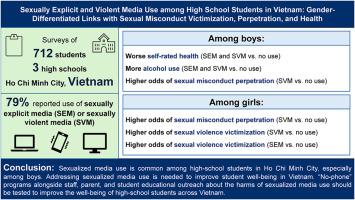Sexually explicit and violent media use among high school students in Vietnam: Gender-differentiated links with sexual misconduct victimization, perpetration, and health
IF 2.6
Q1 PSYCHIATRY
引用次数: 0
Abstract
Background
In lower-income countries, research is lacking on levels and associations of using sexually explicit, physically non-violent media (SEM) or sexually explicit, physically violent media (SVM) with well-being outcomes in high-school students.
Objective
We tested theories of gendered aggression and moral incongruence to explain the associations of SEM use and/or SVM use versus non-use with sexual misconduct perpetration/victimization and other well-being outcomes among students attending three high schools in Ho Chi Minh City, Vietnam.
Method
712 students completed surveys about their general health, mental health, alcohol use, academic disengagement, sexual misconduct perpetration and victimization, beliefs about pro-violence peer norms, and any SEM/SVM use in the prior six months. Unadjusted and adjusted regression models were estimated.
Results
Most reported SEM (47 %) or SVM (32 %) use. SVM use was higher among boys (39 %) than girls (27 %) (χ2 p = 0.01). Among boys, compared to non-users, users reported worse self-rated health (SEM acoef = 0.44 (0.10, 0.78); SVM acoef = 0.58 (0.23, 0.93)), higher alcohol use (SEM aOR = 2.42 (1.06, 5.58); SVM aOR = 2.44 (1.05, 5.62)), and higher sexual misconduct perpetration involving physical dating violence, stalking, or sexual violence (SVM aOR = 5.02 (1.39, 18.06)). Among girls, compared to non-users, SVM users reported higher sexual misconduct perpetration (aOR = 2.59 (1.13, 5.92)) and sexual violence victimization (aOR = 5.74 (1.81, 18.22)); SEM users reported higher sexual misconduct victimization involving physical dating violence, sexual harassment, stalking, or sexual violence (OR = 2.32 (1.33, 4.04)).
Conclusion
Most high-school students in this study reported sexualized media use, and boys reported SVM use more often than girls. Corroborating gendered aggression theory, sexualized media use tended to predict violence perpetration among boys and victimization among girls. Corroborating moral incongruence theory, boys’ use was associated with worse self-rated health and alcohol use. Contextualized programs may reduce student access to common modalities of sexualized media use and educate school communities about the harms of use.

越南高中生使用色情和暴力媒体:性别差异与性行为不端受害、犯罪和健康之间的联系
在低收入国家,缺乏关于高中生使用性暴露、身体暴力媒体(SEM)或性暴露、身体暴力媒体(SVM)与幸福感结果之间的水平和关联的研究。目的对越南胡志明市三所高中学生的性别攻击和道德不一致理论进行检验,以解释SEM的使用和/或SVM的使用与不使用与性行为不端犯罪/受害和其他幸福结果之间的关联。方法712名学生在过去6个月内完成了总体健康、心理健康、酒精使用、学业脱离、性行为不端犯罪和受害、对暴力同伴规范的信念以及任何SEM/SVM使用情况的调查。对未调整和调整后的回归模型进行估计。结果大多数报告使用SEM(47%)或SVM(32%)。男生(39%)使用支持向量机的比例高于女生(27%)(χ2 p = 0.01)。在男孩中,与不使用电子烟的人相比,使用电子烟的人自评健康状况较差(SEM acoef = 0.44 (0.10, 0.78);SVM的acoef = 0.58(0.23, 0.93)),较高的酒精使用(SEM aOR = 2.42 (1.06, 5.58);支持向量机aOR = 2.44(1.05, 5.62)),以及涉及肢体约会暴力、跟踪或性暴力的更高的性行为不当犯罪(支持向量机aOR = 5.02(1.39, 18.06))。在女孩中,与非用户相比,支持向量机用户报告更高的性行为不端犯罪(aOR = 2.59(1.13, 5.92))和性暴力受害(aOR = 5.74 (1.81, 18.22));SEM用户报告了更高的性行为不当受害者,包括身体约会暴力、性骚扰、跟踪或性暴力(or = 2.32(1.33, 4.04))。结论本研究中大多数高中生报告了性媒体的使用,男生报告的SVM使用频率高于女生。证实了性别攻击理论,性化媒体使用倾向于预测男孩的暴力行为和女孩的受害行为。证实道德不一致理论,男孩使用与较差的自我评价健康和酒精使用有关。情境化项目可能会减少学生接触到性媒体使用的常见方式,并教育学校社区了解使用媒体的危害。
本文章由计算机程序翻译,如有差异,请以英文原文为准。
求助全文
约1分钟内获得全文
求助全文

 求助内容:
求助内容: 应助结果提醒方式:
应助结果提醒方式:


